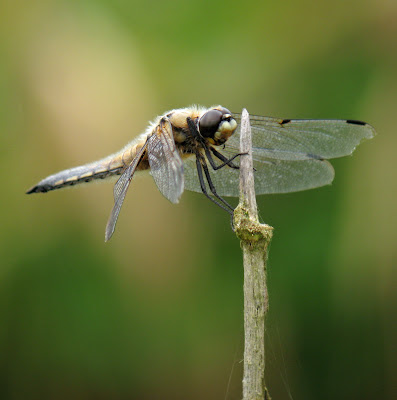The most abundant dragonfly at the moment at Maxey gravel pits is the Four-spotted Chaser. They are everywhere, which is quite pleasing considering the downpours that are becoming the `norm` this summer. This rainfall must be having an affect on the wildlife, especially the insects. The number of butterflies in this country is in free-fall anyway, but this awful summer could see numbers of some species fall perilously low. Dragonflies, too must be feeling the effects of all this wet stuff!
I digress. The images below are all digiscoped as I can`t really get that close with my little hand-held camera, dragonflies are extremely wary and seem to fly at the merest hint of approach.
This species of dragonfly is widespread through most of Britain and fairly common throughout most of its range. It is found throughout Europe and there is no threat to its conservation in Britain, although where sites become over shaded the species seems to have a fall in numbers.
Their flight period lasts from late May until mid-August, with sexually active males being very aggressive and easy to see on the wing as they tend to fly and attack most things that go near them. They are seen perched on emergent vegetation and tend to return to this perch after partaking in a sortie after an intruder has entered their territory and been `seen off`.







Hi John. A very nice series of digi-scoped images clearly showing all the distinguishing features of this species.
ReplyDeleteBTW I can strongly recommend 'Field Guide to Dragonflies and Damselflies of GB and Ireland' by Steve Brooks (Illustrated by Richard Lewington). Published by BWP.
Thanks Frank, very kind of you.
DeleteFunnily enough, that book landed on my doorstep the other day, I am glad it is recommended! ;)
J
Hi John...Here we call it a skimmer instead of chaser..same guy.. different country ; }
ReplyDeleteVery nice photos showing the overall views of the Four spotted!!
Grace
Hi Grace,
DeleteThank you. It always amazes me the different names that are given to the same thing! As long as we both know what we are talking about, it doesn`t really matter, does it?
J
You did a great job being able to digiscope these John, they are never still for very long. It is a good job that we have something to photograph.{:)
ReplyDeleteHi Roy,
DeleteThank you, I got lucky with these few, they came back to their perch after their little forays, helping me to get some sort of photo!
J
These are all great shots John.
ReplyDeleteAnd another recommendation for that book.
Thanks Keith,
DeleteIt does seem to be a good book, recommended by a few people, I will have to try and digest its contents properly! ;)
J
Great shots, John. I'd love to see a chaser here on the Island. Hmm, going to have to look that book up on Amazon now.
ReplyDeleteThanks Omi,
DeleteI am pretty sure that the 4-spot is present on the Isle of Wight, that`s what this book says anyway! ;)
J
Really lovely photos John. You certainly know what you are doing with that digiscoping!
ReplyDeleteFunnily enough the one that landed on my doorstep only yesterday was the 'other' one by Smallshire and Swash, which I have heard very good things of.
Hi Jan,
DeleteThank you, I still need plenty of practice though!
I have heard of that one too, it was a toss up between the two really.
J
Great captures John you really have mastered the art.
ReplyDeleteThanks Andrew,
DeleteAs I have said, I still need plenty of practice!
J
These are really good pictures, thanks for sharing.
ReplyDeleteThanks Gillian, you are too kind.
DeleteJ
John, this weather is having an effect on all life at the moment, not just wildlife!
ReplyDeleteClick here for Bazza’s Blog ‘To Discover Ice’
Very true Bazza, the only thing I would say to that is that only one species has created the climate and environment that we are experiencing and that species can cope an awful lot better than the majority of others.
DeleteJ